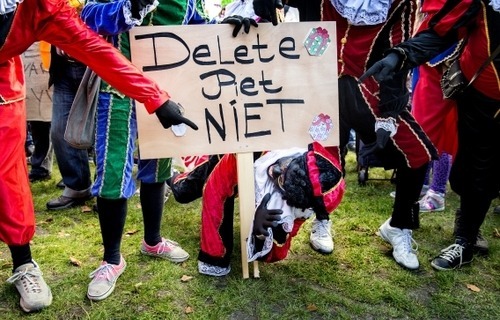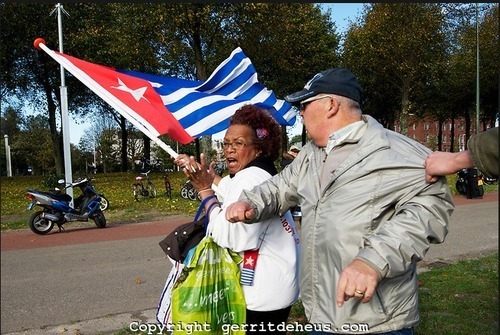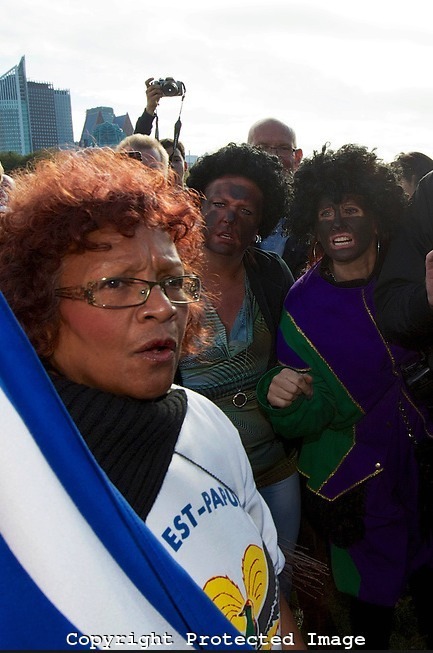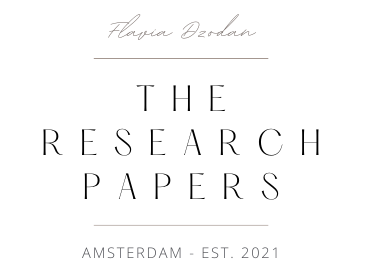An intersectional feminist approximation to aesthetics around Zwarte Piet
If this is the first time you encounter mentions of the character of Zwarte Piet, I’d recommend a few readings on the topic (otherwise, most of this post will make no sense).
bell hooks talks about “white supremacist, imperialist, capitalist, heteronormative patriarchy" to describe the interlocking systems of domination that define our reality and I genuinely cannot think of a more encompassing, wide reaching definition and lens to look at the world. When I started writing (and talking in general) about Zwarte Piet, it was through an initial visceral approximation. This, I wanted to scream, is what fucked up racism looks like. This wasn’t borne out of a deep analysis, it was purely a reactionary approach to a visually offensive image. I was (still am, as you can probably infer by the amount of words I devote to the topic regularly) appalled by the perpetuation of this racist caricature. Yet, the more I delve into the character’s contextual placement in Dutch history and contemporary culture, the more layers I try to "peel off”. I continue to write about this mostly as an exercise in reflexion. Individual, yes, primarily. But hopefully also as a way to add to pre-existing theories and ideas around it. In this, I do not write alone (though I do sit alone and reflect while writing) but I write in what I see as a hopeful choral history from the margins. It is in the margins that I live, after all. I do not belong to any academic institution; my writings on this topic have no place in media (local or international alike) and yet, I commit them to this space with a dual intention 1) that they might add “something” to the dominant, white supremacist discourses 2) that someone might find these sketches (for this is all these are) and feel less lonely, just as I felt less lonely when I found the writings of hundreds (if not thousands) of other radical Women of Color on the internet. So it is through bell hooks definition(s) that I started to look at Zwarte Piet and the myriad ways in which this character is a stand in for other subjects. Zwarte Piet as a metonymy for the “white supremacist, imperialist, capitalist, heteronormative patriarchy”.
Few words define The Netherlands better than “imperialist”. In a time of white appropriations of post colonial theory, few pause to realize that no post colonial analysis is possible while we live in a country where the “post” lays within a distant future (i.e. The Netherlands still holds colonial territories in the Caribbean). Zwarte Piet can only be understood as emerging from the remnants of an Empire terrified of irrelevancy. The Netherlands doesn’t have “nostalgia for the Empire”. That would imply that the Empire is a thing of the past. Even though we can (and do) use post colonial theory to unpack the cultural mechanisms at play, there is no “post” State in The Netherlands that would allow us to attempt analysis as “subjects after the fact”. Moreover, the legal classification of people into “autochtoon” and “allochtoon” is, in and by itself, a colonial device to separate the racial categories we are forced to inhabit. The current colonial subjects (that is, people that live in Dutch colonial territories) are still referred to as “allochtonen”, that is, not belonging. That the colonial subjects that are directly affected by the legacy of the Transatlantic slave trade are coded as “Other” (in the letter of the law, no less) is key to understand the context around Zwarte Piet.
Media has framed the current white Dutch uproar around discussions of racism as the “Zwarte Piet debate”. However, there is no “debate” going on. What is going on is, simply put, a mechanism through which a white supremacist society seeks to establish and perpetuate dominance. This domination is currently challenged by the public interrogation and subsequent implication of a racist character that a great portion of Dutch society considers “indispensable” and “immanent” (both in the sense of “inherent” and “unchangeable”). The demonstration in The Hague this weekend, which gathered around five hundred white Dutch people showing “support” for this character, was a demonstration of power. That is, the power of the White majority to not consider racism. That is, I insist, the power and self appointed right of the White majority to perpetuate racism.
Here, a photo (courtesy of Dutch newspaper NRC) from the demonstration on Saturday:

Without having to state the obvious, I invite readers to look at the position of the character and the sign he is holding: “Do not delete Zwarte Piet”
The argument we hear the most in this so called “debate” is that the character is not racist but merely a cartoon like comic relief. “Black from soot” we hear often. Not Black from racist blackface. These “arguments”, however, shattered when on Saturday, during the demonstration, the crowd attacked a Woman of Color who was trying to bring attention to the human rights abuses currently taking place in West Papua by Indonesian military (Indonesia, it should be noted, is a former colony of the Dutch Empire). I use “generic” Woman of Color because I am uncomfortable second guessing her preferred identity definition. She is of Papuan heritage, that much is known. The crowd “confused” a dark skinned woman with an anti Zwarte Piet activist and unleashed violence (both verbal and physical, requiring police intervention after a photographer prevented the woman from being beaten up by white supremacists).
There are two photos, taken by photographer and documentarist Gerrit de Heus (the man who intervened when violence against the lone woman of Papuan heritage ensued) that have shaken me deeply. Usually, when we talk about aesthetics, we are referring to underlying beauty. As a matter of fact, aesthetics, as a philosophical field, are concerned purely with beauty and the appreciation of beauty. However, I am more interested in a representation of what I’d call “the aesthetics of white supremacist, imperialist, capitalist, heteronormative patriarchy”. An aesthetics of the imposed monster, if you will. An aesthetic of breath taking horror.


(It bears repeating, both photos were taken by Gerrit de Heus, more photos of the demonstration at his site here)
Zwarte Piet “implicates” Dutch society in the sense that it visibilizes the violence that hides beneath assertions of “tolerance”. This, I contend, is what the white supremacist, imperialist, capitalist, heteronormative patriarchy looks like. White men and White women attacking “a former subject of the Empire”, the racist “confusion” of this woman’s heritage because in this mindset, “we are all the same”.
In Traveling Concepts in the Humanities: A Rough Guide, Mieke Bal writes:
This tradition is particularly troublesome because “sophisticated”, with racism being worked over by classism (Zwarte Piet are servants) and sexism (they are feminized). The clownish behavior even flirts with the traditional question raised in the sixteenth century, and again in the eighteenth, and then right up to the time of abolition, of whether blacks were quite human. No relativizations of the deeply racist ideology that underlies this tradition are possible.
This, is the exact formulation of why I look at all these cultural expressions through the lens articulated by bell hooks. The way this character embodies racism, classism, sexism and white supremacy in action. However, I contend that this embodiment does not remain only within the character. These qualities are then passed on those of us coded as “Other”, particularly, if we are perceived as a threat to the perpetuation of these hierarchies.
There is plenty written around feminist aesthetics. Or perhaps, a better formulation would be “there is plenty written around a feminist approximation to aesthetics”. I have read Julia Kristeva’s work about the abject and, while the ideas resonate with me on some level, they fall short of addressing the racist, rendering her work of little use “to understand the world around me” (which is, to this day, the best way to explain my use of theory and/ or philosophy). It is, in a sense, as if, together with having rendered “whiteness” as the neutral, we were offered white analysis of aesthetics, devoid of any other intersection, as the only way to understand the subject. Since that is the case, I have little tools to look at the photos above, except to see them as the visual representation of the monstrous, the horror we are forced to bear witness to and endure on our bodies, as women, as feminists, as womanists, as women of color, as any or all of the above. This, I contend, is a captured moment in the ongoing, vicious violence underlying “debates” around Zwarte Piet. This is what white supremacist, imperialist, capitalist patriarchy will do to protect itself from change.
For the past decade and a half I have been making all my content available for free (and never behind a paywall) as an ongoing practice of ephemeral publishing. This site is no exception. If you wish to help offset my labor costs, you can donate on Paypal or you can subscribe to Patreon where I will not be putting my posts behind a lock but you'd be helping me continue making this work available for everyone. Thank you. Follow me on Twitter for new post updates.

